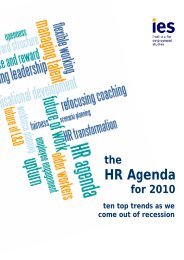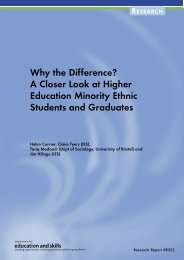Post-16 Transitions: a Longitudinal Study of Young People with ...
Post-16 Transitions: a Longitudinal Study of Young People with ...
Post-16 Transitions: a Longitudinal Study of Young People with ...
Create successful ePaper yourself
Turn your PDF publications into a flip-book with our unique Google optimized e-Paper software.
Selection <strong>of</strong> schools for top-up sample<br />
The overall aim was to draw a sample <strong>of</strong> 345 schools, on the basis<br />
that 115 would agree to participate in the research (based on a 30<br />
per cent response rate). The population was defined as all<br />
mainstream secondary schools in England, excluding those that<br />
participated in Wave 1 and middle deemed-secondary schools. As<br />
special schools were over-represented in Wave 1, they were<br />
excluded from the top-up sample although young people from<br />
special schools remain over-represented in the sample. This was<br />
important to ensure sufficient special school students in the<br />
sample to enable comparisons <strong>with</strong> mainstream school students to<br />
be made.)<br />
MORI’s approach to the selection <strong>of</strong> schools for the top-up sample<br />
comprised the following procedures:<br />
• The sampling frame was stratified by Government Office<br />
Region (GOR) in England.<br />
• Within each GOR, schools were selected <strong>with</strong> a probability<br />
proportionate to the size <strong>of</strong> school register (ie pupil<br />
population).<br />
• The selected sample <strong>of</strong> schools were compared against<br />
population pr<strong>of</strong>iles to ensure that it was representative.<br />
Table A.1 gives pr<strong>of</strong>ile information for participating schools as<br />
well as population pr<strong>of</strong>iles.<br />
Selection <strong>of</strong> pupils<br />
The nominated SENCO/teacher was then contacted by a MORI<br />
interviewer to arrange a time to visit the school. During this visit,<br />
the interviewer assisted the SENCO/teacher <strong>with</strong> completing the<br />
Pupil Information Form (PIF) and the administration <strong>of</strong> the optout.<br />
1<br />
The PIF was divided into two parts: the first part collected a<br />
limited number <strong>of</strong> variables about each eligible pupil (eg gender,<br />
SEN stage in Year 11/2000-01); and the second part collected their<br />
contact details. The first part was completed for a maximum <strong>of</strong> 30<br />
eligible pupils 2 and the second part was completed only for those<br />
pupils that did not opt-out <strong>of</strong> the study.<br />
1 This is to minimise the burden on schools but schools, if they chose<br />
to, could carry out this process themselves.<br />
2 In the pilot, MORI tested two approaches: a census and a maximum<br />
<strong>of</strong> 40 eligible pupils. The findings from the pilot showed that the<br />
maximum number <strong>of</strong> eligible pupils tended to be 30. Thus the<br />
decision was taken in the main stage to cap the maximum number <strong>of</strong><br />
148<br />
<strong>Post</strong>-<strong>16</strong> <strong>Transitions</strong> <strong>of</strong> <strong>Young</strong> <strong>People</strong> <strong>with</strong> SEN: Wave 2

















